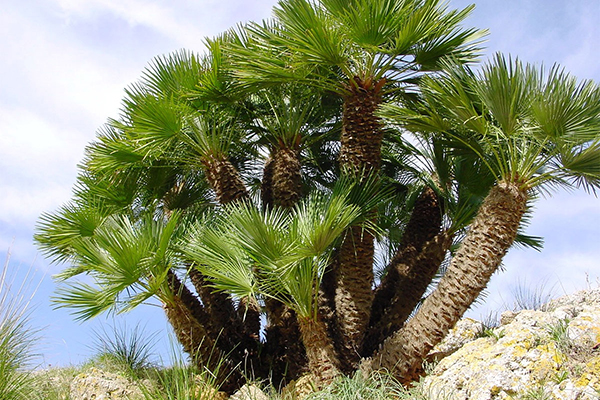By Betty Beeman

Palms are not native to Arizona but they are found all over the Valley – Palm Valley Golf Club in Goodyear, Mission Palms Hotel in Tempe, Royal Palms Resort in Phoenix and the campus of Arizona State University – the list goes on and on.
Palms are planted in groves, clumps or as single specimens for accent or background planting around swimming pools, patios, and in the garden wherever a bold effect is desired. The slow growing and dwarf species can be planted in tubs or planters.
Some of the hardiest palm species for this area are California fan (50 feet), Mediterranean fan, a multi-trunked palm (10-15 feet), windmill fan (25 feet), Canary Island date (40 feet) and Mexican blue (70 feet).
The choice of which one to purchase and plant can be intimidating. However, you can narrow down your selection by considering the following:
■ How big it will be at maturity, and its location (watch out for power lines at your site).
■ Will it overpower the home? I have seen palms planted close to foundations. This may look good but it can cause problems as it grows. It can be costly when you have to call in a person to take it out. So don’t plant that cute little 5-gallon palm near anything it can overtake such as your house and garden.
[quote_box_right]December Gardening Tip
Transplant: chard, celery, broccoli, asparagus, kohlrabi[/quote_box_right]
1. Planting
Take care to avoid planting in frost pockets, where nighttime cold air tends to collect. Palms are most sensitive to cold as small plants. As the tree approaches maturity it can withstand low temperatures with less injury.
The best time for planting is during warm weather when root growth is most active. Soil temperatures above 65 degrees aid in root establishment. The preferred time to plant is late spring to early summer.
A well drained soil will promote growth.
Caliche, hardpan or compacted soil layers prevent good soil drainage. To test for drainage, fill hole with water, allow to drain and fill a second time. If second filling does not drain within 24 hours find another location or dig a chimney down to a porous strata to permit excess irrigation water to drain from hole.
Do not amend the backfill with manure or organic material. This will result in the palm sinking into the hole. Dig the hole as deep as the root ball and 2 feet wider on each side. Seat the crown of the container palm at the original soil level. Do not cover the crown or young trunk with soil. New roots will emerge both above and below the root ball. Settle the backfill with water from a hose.

2. Watering & Feeding
Water thoroughly at planting time. Make a berm above grade about 2 feet out from the trunk so that a slow soak from hose or bubbler can gradually fill it and saturate the root zone. Palms set out in warm weather will probably need to be watered every day the first two weeks. Check moisture content in the root ball to determine moisture. The goal is to keep the root ball moist but not soggy wet.
As roots begin to grow out and draw moisture from a greater distance, irrigation can be spaced farther apart, from every day the first two weeks to once every seven days. Use probe (piece of rebar or a long screw driver) to test for moisture depth. The goal is to water to a depth of 2 feet. Spread a layer of mulch 2-4 inches deep to conserve moisture and reduce soil temperature. Established palms do well on slow irrigation to a depth of 2 feet every two weeks.
Fertilize with palm fertilizer according to package directions twice a year.
Questions? Contact a Master Gardener volunteer
520-374-6263
[email protected]
This column appears in the December issue of InMaricopa.



![Elena Trails releases home renderings An image of one of 56 elevation renderings submitted to Maricopa's planning department for the Elena Trails subdivison. The developer plans to construct 14 different floor plans, with four elevation styles per plan. [City of Maricopa]](https://www.inmaricopa.com/wp-content/uploads/2024/04/city-041724-elena-trails-rendering-218x150.jpg)

![Affordable apartments planned near ‘Restaurant Row’ A blue square highlights the area of the proposed affordable housing development and "Restaurant Row" sitting south of city hall and the Maricopa Police Department. Preliminary architectural drawings were not yet available. [City of Maricopa]](https://www.inmaricopa.com/wp-content/uploads/2024/04/041724-affordable-housing-project-restaurant-row-218x150.jpg)










![Elena Trails releases home renderings An image of one of 56 elevation renderings submitted to Maricopa's planning department for the Elena Trails subdivison. The developer plans to construct 14 different floor plans, with four elevation styles per plan. [City of Maricopa]](https://www.inmaricopa.com/wp-content/uploads/2024/04/city-041724-elena-trails-rendering-100x70.jpg)

![Affordable apartments planned near ‘Restaurant Row’ A blue square highlights the area of the proposed affordable housing development and "Restaurant Row" sitting south of city hall and the Maricopa Police Department. Preliminary architectural drawings were not yet available. [City of Maricopa]](https://www.inmaricopa.com/wp-content/uploads/2024/04/041724-affordable-housing-project-restaurant-row-100x70.jpg)